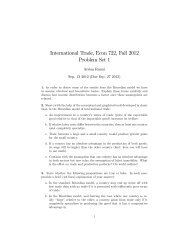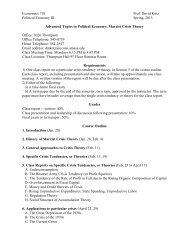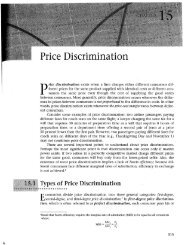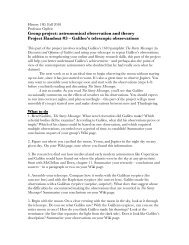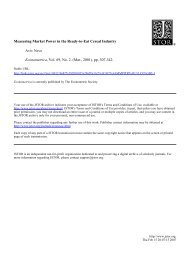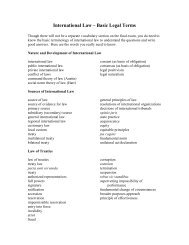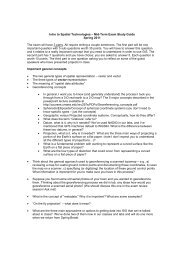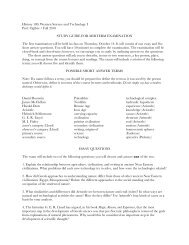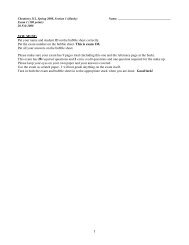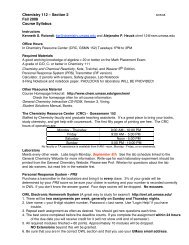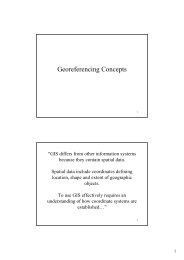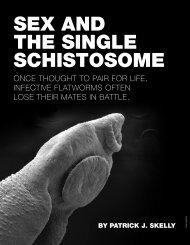Chemistry 112, Spring 2008, Section 1 (Hardy) Name: Final Exam ...
Chemistry 112, Spring 2008, Section 1 (Hardy) Name: Final Exam ...
Chemistry 112, Spring 2008, Section 1 (Hardy) Name: Final Exam ...
- No tags were found...
Create successful ePaper yourself
Turn your PDF publications into a flip-book with our unique Google optimized e-Paper software.
<strong>Chemistry</strong> <strong>112</strong>, <strong>Spring</strong> <strong>2008</strong>, <strong>Section</strong> 1 (<strong>Hardy</strong>)<strong>Final</strong> <strong>Exam</strong> (150 points)16 May <strong>2008</strong><strong>Name</strong>: _______________________________Version AYOU MUST:(1) Put your name and student ID on the bubble sheet correctly.(2) Write the exam Version (A or B) on the upper left side of the bubble sheet above the word “NAME”.This exam is Version “A”.(3) Put all your answers on the bubble sheet.(4) When you are finished, turn the bubble sheet and the first page of the exam with your name on it.This exam has 40 required problems and 4 extra credit problems.Please make sure your exam has 11 pages (not including this one and the reference page at the back).Please keep your eyes on your own paper and your answers covered.Use the exam as scratch paper. We will not grade anything on the exam itself.Good luck!Questions 1-13: comprehensive questionsQuestions 14-28: themodynamicsQuestions 29-40: electrochemistryQuestions 41-44: Extra Credit
1. Construct phase diagrams for each of the following compounds based on the information in thetable below. Which of the following gases can be liquefied at 25 °C?Gas Boiling pt. critical temp.CH 4 -161.5 °C -82.6 °CC 3 H 8 -42.1 °C +96.7 °CO 2 -183 °C -119 °CAnswer: ba) CH 4 onlyb) C 3 H 8 onlyc) O 2 onlyd) CH 4 and O 2e) C 3 H 8 and O 22. The intermolecular attractive forces would be greatest in which of the following molecules:CH 3 CH 3 , CH 2 Br 2 and CH 3 CH 2 OH.Answer: d(a) CH 3 CH 3(b) CH 2 Br 2(c) the same in all three molecules(d) CH 3 CH 2 OH(e) CH 3 CH 3 and CH 2 Br 23. What is the freezing point of a solution containing 4.78 g naphthalene (molar mass = 128.2 g/mol)dissolved in 32.0 g paradichlorobenzene? The freezing point of pure paradichlorobenzene is53.0 °C and the freezing point depression constant, K fp , is -7.10 °C/m.a) -1.63 °Cb) 44.7 °Cc) 46.9 °Cd) 51.9 °Ce) 52.1 °CAnswer: b4. For the figure at the right, one linerepresents the vapor pressure of purewater, one line represents the vaporpressure of 1M NaCl and one linerepresents the vapor pressure of 1MMgCl 2 . Two of the lines are irrelevant.Which line represents 1 M NaCl?a) line a
Answer: d8. At 800 K, the equilibrium constant, K p , for the following reaction is 3.2 × 10 -7 .2 H 2 S(g) 2 H 2 (g) + S 2 (g)A reaction vessel at 800 K initially contains 3.50 atm of H 2 S. If the reaction is allowed toequilibrate, what is the equilibrium pressure of H 2 ?a) 1.0 × 10 -3 atm b) 2.1 × 10 -3 atm c) 5.0 × 10 -3 atm d) 9.9 × 10 -3 atm e) 2.0 × 10 -2 atmAnswer: e9. An aqueous solution with a pH of 3.00 is diluted from 2.0 L to 4.0 L. What is the pH of the dilutedsolution?a) 1.50 b) 1.73 c) 3.00 d) 3.30 e) 6.00Answer: d10. For the following reaction, K < 1. Which of the products or reactants is the strongest Bronsted-Lowry acid?NO 2- + C 17 H 19 O 3 NH + C 17 H 19 O 3 N + HNO 2a. NO 2-b. C 17 H 19 O 3 NH +c. C 17 H 19 O 3 Nd. HNO 2e. Cannot be determined without knowing K a and K b for each species.Answer: d11. Which of the following combinations would be best to buffer an aqueous solution at a pH of 2.0?a) H 3 PO 4 and H 2 PO 4- , K a1 = 7.5 × 10 -3b) HNO 2 and NO 2- , K a = 4.5 × 10 -4c) CH 3 CO 2 H and CH 3 COO - , K a = 1.8 × 10 -5d) H 2 PO 4- and HPO 42-, K a2 = 6.2 × 10 -8e) NH 4+ and NH 3 , K a = 5.7 × 10 -10Answer: a12. A 50.0 mL sample of vinegar is titrated with 0.774 M NaOH(aq). If the titration requires 41.6 mLof NaOH(aq), what is the concentration of acetic acid in the vinegar?a) 0.0921 M b) 0.429 M c) 0.644 M d) 0.930 M e) 0.967 MAnswer: c
13. An enzymatic catalyst called catalase is added to a solution of H 2 O 2 to degrade the H 2 O 2 . Which ofthe following statements are true?a. ΔG for H 2 O 2 degradation is more negative in the presence of catalase.b. ΔS sys is more negative in the presence of catalase.c. The reaction rate is faster in the presence of catalase.d. The equilibrium constant K is effected by the presence of catalase.e. The reaction changes from exothermic to endothermic in the presence of catalase.Answer c14. Which chemical principle tells us that all components of a reaction must be balanced?a. The first law of thermodynamicsb. The second law of thermodynamicsc. The third law of thermodynamicsd. The organization of the periodic tablee. The relationship of absolute zero to infinityAnswer a15. Which of these is not a way to think of the 2 nd law of thermodynamics?a. The universe tends to greater and greater disorderb. Molecules are like undergraduates; they like to leave their options open.c. A reaction is spontaneous if the entropy of the universe is positive.d. The entropy of a perfect crystal at absolute zero is 0.e. Spontaneous change results in the dispersal of energy.Answer d16. Reactants A and B are placed in an empty flask. If the reaction A(g) + B(g) 2 C(g) has K p >1, which of the following statements are correct?1. The forward reaction is spontaneous.2. The forward rate of reaction is fast.3. The reaction is reactant-favored.a) 1 only b) 2 only c) 3 only d) 1 and 2 e) 1, 2, and 3Answer: a17. Statistically, why does the entropy of the universe increase?a. The universe is principally composed of gases and the entropy of gases is less than that ofsolids.b. Disorder is more likely than order because there are so many more ways to be disordered.c. The entropy of the system always increases for spontaneous reactions.d. The more complex a system, the lower the entropy.e. At high temperature entropy of a system is lower than at low temperatures.Answer b
Answer: d23. Which of the following reactions are not spontaneous under standard conditions 25 °C?1. 2C 4 H 10 (g) + 13O 2 (g) 8CO 2 (g) +10 H 2 O; ΔHº = -513 kJ ΔSº = 312 J/K2. C(graphite) + 2H 2 (g) CH 4 (g); ΔHº = -74.9 kJ ΔSº = -80.7 J/K3. N 2 (g) + 2H 2 (g) 2N 2 H 4 (g); ΔHº = 50.6 kJ ΔSº = -331 J/Ka) 1 only b) 2 only c) 3 only d) 1 & 2 e) 1 & 3Answer c : 1. ΔGº = -606 kJ, 2. ΔGº = -50.8 kJ, 3. ΔGº = +50.6 kJ24. For a chemical reaction, if ΔGo = 0, thena) K > 1 b) K = 0 c) K < 1 d) K < 0 e) K = 1Answer: e25. If ΔGº < 0 for a reaction at all temperatures, then ΔHº is ________ and ΔSº is ________.a) negative, positiveb) positive, negativec) negative, negatived) positive, positivee) positive, either positive or negativeAnswer: a26. The standard free energy change for a chemical reaction is -18.3 kJ/mole. What is the equilibriumconstant for the reaction at 87 °C? (R = 8.314 J/K·mol)a) 2.2 × 10 -3 b) 1.0 c) 6.1 d) 4.5 × 10 2 e) 1.3 × 10 6Answer: d27. At what temperatures will a reaction be spontaneous if ΔH = +158 kJ and ΔS = +411 J/K?a) All temperatures below 384 Kb) Temperatures between 158 K and 411 Kc) All temperatures above 384 Kd) The reaction will be spontaneous at any temperature.e) The reaction will never be spontaneous.Answer: c28. What is the value of Gº for the reaction below at 25C?Pb +2 (aq) + S -2 (aq) PbS (s) K sp = 3 x 10 -28a. 157 kJ/molb. -157 kJ/mol
c. 63 kJ/mold. -63 kJ/mole. 12 kJ/molAnswer b29. Assuming the following reaction proceeds in the forward direction,Ni 2+ (aq) + Cr(s) Ni(s) + Cr 2+ (aq)a) Ni 2+ (aq) is oxidized and Cr(s) is reduced.b) Ni 2+ (aq) is oxidized and Ni(s) is reduced.c) Ni(s) is oxidized and Ni 2+ (aq) is reduced.d) Cr(s) is oxidized and Cr 2+ (aq) is reduced.e) Cr(s) is oxidized and Ni 2+ (aq) is reduced.Answer: e30. The following reaction occurs spontaneously.3 Cu 2+ (aq) + 2 Fe(s) 2 Fe 3+ (aq) + 3 Cu(s)Write the balanced oxidation half-reaction.a) 2 Fe(s) 2 Fe 3+ (aq) + 6 e -b) 2 Fe(s) + 6 e - 2 Fe 3+ (aq)c) 3 Cu 2+ (aq) + 6 e - 3 Cu(s)d) 3 Cu 2+ (aq) 3 Cu(s) + 6 e -e) 3 Cu(s) 3 Cu 2+ (aq) + 6 e -Answer: a31. In class we had a demonstration of the redox reaction of Aluminum foil in a solution of coppersulfate. A dark precipitate appeared on the aluminum foil. What was the precipitate?a. Al +3b. Cu (s)c. Al(s)d. Cu +2e. Al 2 O 3Answer : b
32. For the skeletal reaction Pb 2+ + Hg 2+ PbO 2 + Hg, what is the balanced overall reactionequation under acidic conditions?a. Pb 2+ + Hg 2+ + H 2 O PbO 2 + Hg + 4 H +b. 2Pb 2+ + 3Hg 2+ + 2 H 2 O PbO 2 + 2Hg + 4 H +c. Pb 2+ + Hg 2+ + 2 H 2 O PbO 2 + Hg + 4 H +d. Pb 2+ + Hg 2+ PbO 2 + Hg +e. Pb 2+ + 2Hg 2+ + 2 H 2 O PbO 2 + Hg + 4 OH -Answer c33. When skeletal equation SnO 3 2- + Br 2 BrO 3 - + SnO 2 -2 is balanced under basic conditions,how much water appears and on which side of the balanced equation?a. 12 H 2 O ; productb. 5 H 2 O ; productc. 1 H 2 O ; productd. 1 H 2 O ; reactante. 2 H 2 O ; reactantAnswer c34. All of the following statements concerning voltaic cells are true EXCEPTa) a salt bridge allows cations and anions to move between the half-cells.b) electrons flow from the cathode to the anode.c) reduction occurs at the cathode.d) a voltaic cell can be used as a source of energy.e) a voltaic cell consists of two-half cells.Answer: b35. A Chem <strong>112</strong> student builds a standard voltaic cell composed of one Zn(s) / Zn 2+ (aq) half cell, andone Ni (s) / Ni 2+ (aq) half cell. The standard reduction potential for Zn +2 is -0.763 V.The standardreduction potential for Ni +2 is -0.25 V. What is the cathode made from?a. Zn(s)b. Zn 2+ (s)c. Ni 2+ (s)d. Ni (s)e. Pt (s)Answer d36. Given the following two half-reactions, determine which overall reaction is spontaneous andcalculate its standard cell potential.
Cd 2+ (aq) + 2 e - Cd(s) E° = -1.21 VSn 2+ (aq) + 2 e - Sn(s) E° = -0.14 Va) Cd 2+ (aq) + Sn(s) Cd(s) + Sn 2+ (aq) E = +1.07 Vb) Cd 2+ (aq) + Sn(s) Cd(s) + Sn 2+ (aq)c) Cd(s) + Sn 2+ (aq) Cd 2+ (aq) + Sn(s)d) Cd(s) + Sn 2+ (aq) Cd 2+ (aq) + Sn(s)e) Cd(s) + Sn 2+ (aq) Cd 2+ (aq) + Sn(s)Answer: cocelloEcell= -1.35 VoEcell= +1.07 VoEcell= -1.07 VoEcell= +1.35 V37. Use the standard reduction potentials below to determine which element or ion is the best reducingagent?Pd 2+ (aq) + 2 e - Pd(s) E° = +0.90 VSn 2+ (aq) + 2 e - Sn(s) E° = -0.14 VCr 2+ (aq) + 2 e - Cr(s) E° = -0.91 Va) Pd 2+ b) Pd(s) c) Sn 2+ d) Cr 2+ e) Cr(s)Answer: e38. Which of the reactions below is reactant favored given the standard reduction potentialslisted here?Ag + (aq) + e - Ag(s) E° = +0.80 VCu 2+ (aq) + 2 e - Cu(s) E° = +0.34 VSn 4+ (aq) + 2 e - Sn 2+ (aq) E° = +0.15 Va. Cu +2 + 2 Ag (s) 2Ag + + Cu (s)b. 2Ag + + Cu (s) Cu +2 + 2 Ag (s)c. 2Ag + + Sn 2+ (aq) Sn 4+ (aq) + 2 Ag (s)d. Ag + + Sn 2+ (aq) Sn 4+ (aq) + Ag (s)e. Ag + + Cu (s) Cu +2 + Ag (s)Answer a39. What is the greatest possible number of volts that can be generated from connecting fourvoltaic cells made from the following two half reactions?Al 3+ (aq) + 3 e - Al(s) E° = -1.66 VSn 2+ (aq) + 2 e - Sn(s) E° = -0.14 Va. 7.20 Vb. 6.08Vc. 1.8 Vd. 1.52V
e. -1.52 V40. In class we built a Zn(s) | Zn 2+ (aq) || Cu 2+ (aq) | Cu(s) voltaic cell that we used to run either a clockor a buzzer. In this voltaic cell, what served as the salt bridge containing dissolved NaCl ions?a. A strip of cloth hooked to the + electrodeb. A u-tube filled with a slurry of NaClc. A piece of filter paper on which we had drawn a black ink lined. A porous ceramic cupe. Some steel woolAnswer d41. (Extra Credit). An electrochemical process is used to purify copper. Which of the followingstatements best describes the process outlined in the text book?a. Copper is electrochemically dissolved from contaminated riversb. Copper is electroplated onto copper cathodesc. Copper is oxidized from copper cathodes and dissolvesd. Copper (element 29) is generated from hydrogenation of Ni (element 28)e. Copper is oxidized by the platinum anodeAnswer b42. (Extra Credit) We have considered entropy in terms of dispersal of matter and dispersal of energy.In that context which of the following are the most accurate?a.The ΔH reflects the dispersal of energy, whereas ΔS surroundings reflects dispersal of matter.b.The ΔS sys reflects the dispersal of energy, whereas ΔS surroundings reflects dispersal of matter.c.The ΔH reflects the dispersal of energy, whereas ΔS sys reflects dispersal of matter.d. The ΔG reflects the dispersal of energy, whereas ΔH reflects dispersal of matter.e. The ΔH reflects the dispersal of energy, whereas ΔS surroundings reflects dispersal of matter.Answer c43. The effect of adding a catalyst to a reaction is toa) increase the number of collisions between reactants.b) increase the energy of the products.c) increase the equilibrium constant of a reaction.d) lower the activation energy of a reaction.e) decrease the enthalpy change of a reaction.Answer: d
44. (Extra Credit) Consider the reaction A(g) 2 B(g) where K p = 5.0 at 25 °C. If 0.50 mol A and2.0 mol B are introduced into a 1.0 L flask at 25 °C, what change in concentrations (if any) willoccur in time?a) [A] will decrease and [B] will decrease.b) [A] will decrease and [B] will increase.c) [A] will increase and [B] will increase.d) [A] will increase and [B] will decrease.e) [A] and [B] remain unchanged.Answer: d
PERIODIC TABLE OF THE ELEMENTS1A 2A 3B 4B 5B 6B 7B 8B 8B 8B 1B 2B 3A 4A 5A 6A 7A 8A1H1.0083Li6.93911Na22.9919K39.1037Rb85.4755Cs132.987Fr(223)4Be9.01212Mg24.3120Ca40.0838Sr87.6256Ba137.388Ra226.021Sc44.9639Y88.9157La138.989Ac227.022Ti47.9040Zr91.2272Hf178.5104Unq(261)23V50.9441Nb92.9173Ta181.0105Unp(262)24Cr52.0042Mo95.9474W183.8106Unh(263)25Mn54.9443Tc(99)75Re186.2107Uns(262)26Fe55.8544Ru101.176Os190.2108Uno(265)27Co58.9345Rh102.977Ir192.2109Une(266)28Ni58.7146Pd106.478Pt195.129Cu63.5547Ag107.979Au197.030Zn65.3948Cd<strong>112</strong>.480Hg200.65B10.8113Al26.9831Ga69.7249In114.881Tl204.46C12.0114Si28.0932Ge72.6150Sn118.782Pb207.27N14.0115P30.9733As74.9251Sb121.883Bi209.08O16.0016S32.0734Se78.9652Te127.684Po(209)9F19.0017Cl35.4535Br79.9053I126.985At(210)2He4.00310Ne20.1818Ar39.9536Kr83.8054Xe131.386Rn(222)Avogadro Number = 6.023 x 10 23Faraday Const., F = 96.48 kJ/(mole e —·V)ax 2 + bx + c = 0x = [-b ± sqrt(b 2 – 4ac)]/(2a)ΔT fp =K fp m soluteΔT bp =K bp m solute∆T = KmiΠ = cRTS g = k H P goP A = X A P AΔS univ = ΔS sys + ΔS surrΔS° rxn = ΔS°(products) – ΔS°(reactants)pH = pK A + log([A — ]/[HA])pH = -log[H 3 O + ]pK a =-log (K a )14 = pH + pOHpK w = pH + pOHpK w = pK a + pK bK W = [H 3 O + ][OH — ] = 10 -14USEFUL INFORMATIONRoom Temp = 25 °C = 298 KT (°C) + 273 = T (K)ln(P 2 /P 1 ) = (-ΔH vap /R)(1/T 2 –1/T 1 )PV = nRTln(k 2 /k 1 ) = (-E a /R)(1/T 2 – 1/T 1 )t 1/2 = 0.693/kΔS = q rev /T = -ΔH sys /TS = k B lnWk B = 1.381 x 10 -23 J/KΔG = ΔH – TΔSΔG = -nFE1 atm = 760 mm HgK W = [H 3 O + ][OH — ] = 10 -14R = 0.008314 kJ/(mol·K)= 0.08206(L·atm)/(mol·K)ln([A] t /[A] 0 ) = -kt1/[A] t - 1/[A] 0 = kt[A] 0 – [A] t = kt[A] t = [A] 0 e - ktΔG° = -RTlnK eqΔG = ΔG° + RTlnQE° = (RT/nF)lnK eqE = E° - (RT/nF)lnQ



